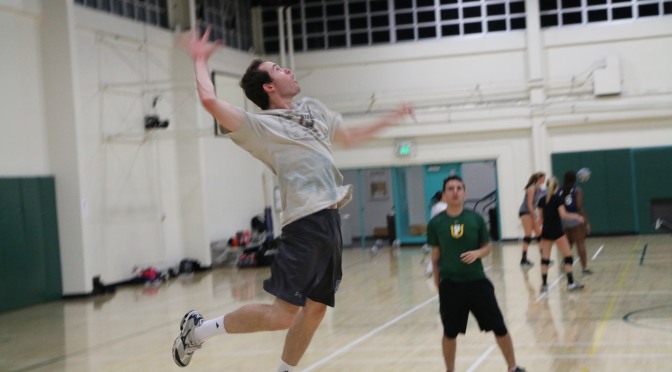Hayden Gehr
Staff Writer
There was a very relaxed, casual atmosphere in the Koret Center’s Hagan Gym during the minutes before the USF men’s volleyball club began their Wednesday night practice. Head coach Corydon Kintz arrived early, without a doubt excited to see the new carbon fiber volleyball poles that were replacing the 25-year-old poles in place since Koret first opened. Practice was set for 7:30, but many students arrived late.
However, the laid-back attitudes quickly disappeared. Once the nets were in place and practice began, a wave of intensity filled the gym, and each player took on a serious demeanor. The team ran a series of offensive drills, which often ended in an emphatic spike over the net.
Nick Macker, a junior philosophy major, is the president of the men’s volleyball club and the successor to senior Victor Gavallos, who is graduating at the end of the semester. Macker discovered the club as a freshman after someone spotted him playing volleyball in Gleeson Plaza and encouraged him to join. Two years later, he has no regrets.
“It’s a good community, everyone really gets along,” Macker said. “It’s always nice to take out some stress while playing volleyball.”
Kintz, who graduated from USF this past May with a degree in history, has been involved with the team ever since the club was founded in 2011. He assumed his coaching position in 2012, and since then has come to understand the importance of club sports on college campuses.
“Making a successful volleyball club has been mainly about two things – to make a social environment that is contributive to long lasting friendships, and the second thing is also to create an environment where people who are not experienced can come and learn, and become competitive players,” Kintz said.
The team is equipped with a variety of talented players, and is in the process of joining an adult league in the Bay Area, but it lacks the highly competitive nature that Division 1 varsity sports possess. However, since USF does not have a varsity men’s volleyball team, the club represents the most advanced level of men’s volleyball at the university.
Kintz has not heard of any developing efforts to make men’s volleyball an NCAA sport at USF, but he doesn’t think it would be out of the question.
“It is certainly not impossible, and there are the facilities and the expertise around to develop a varsity team down the line, if that was something the university wanted to take seriously,” Kintz said.
Schools such as BYU and Pepperdine, which compete against USF in the West Coast Conference, have varsity men’s volleyball teams. Though there is not a men’s volleyball league in the WCC, the teams participate in the Mountain Pacific Sports Federation (MPSF), along with the likes of Stanford, UCLA, and USC. Aside from BYU and Hawaii, all of the schools in the MPSF are in California, so if USF were to ever consider starting a Division 1 men’s volleyball team, it seems that this league would be the ideal fit.
Macker doesn’t think that volleyball’s reputation as primarily a women’s sport is a legitimate reason as to why men’s volleyball has yet to become a varsity sport at USF.
“Up here [in the Bay Area], there are a bunch of good [men’s] volleyball teams,” Macker said. “So I guess there is kind of that stigmatism, but not as much as one would think.”
Kintz also downplays the difference in popularity between men’s and women’s volleyball.
“It is certainly true that there are way more women’s volleyball players, but especially in California, volleyball is also a men’s sport,” Kintz said. “And people who are around volleyball and aware of volleyball know that men’s volleyball is incredibly competitive and also very difficult.”
Both Macker and Kintz would be happy to see a varsity men’s volleyball team at USF in the future, but they are more than content to be playing club volleyball. Heading into college, Macker was looking into playing Division 1 volleyball, but he opted to attend USF and play the less time-constraining club sport.
Although not all players in the men’s volleyball club have the height or skill to compete at the Division 1 level, the students still attempt to emulate the habits and tendencies of a varsity-type volleyball team.
“Teams deserve to become varsity-competing programs when they exert a level of seriousness and dedication,” Kintz said. “I think we’re definitely developing a culture of self-improvement, and also social belonging.”

